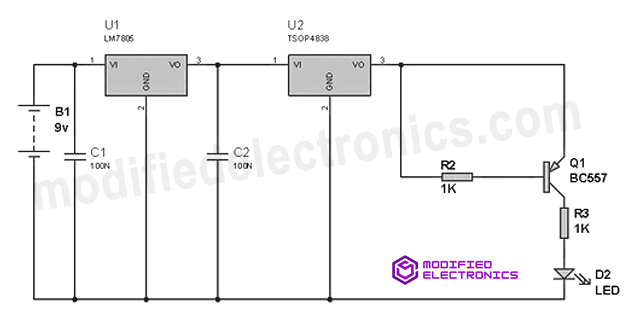Introduction:
The Basic Remote Tester using TSOP 4838 infrared (IR) sensor, is a simple yet effective circuit designed to test the functionality of remote controls. This compact device helps enthusiasts and technicians ensure their remote controls are emitting signals correctly. Let’s explore how this circuit works and its potential applications.
Hardware Required:
Circuit Diagram:

Working:
The working of Basic Remote Tester using TSOP 4838 is simple the TSOP 4838 is an IR receiver that can detect infrared signals from remote controls. In this circuit, the TSOP 4838 is connected to the positive supply through a 1K resistor and to the negative supply. The output of the TSOP is fed into the base of a BC557 transistor through a 1K resistor. The collector of the transistor is connected to the positive supply, and the emitter is connected to the ground through the LED.
When an IR signal is received by the TSOP 4838, it produces a corresponding voltage at its output. This voltage is then amplified by the transistor, allowing enough current to flow through the LED, making it light up. This indicates that the remote control is emitting signals properly.
The LM7805 IC is a voltage regulator that ensures a stable 5V supply for the TSOP 4838 and other components in the circuit.
Applications:
- Remote Control Testing: The primary application is testing remote controls to verify if they are emitting signals correctly. This is useful for diagnosing issues with home appliances, TVs, and other devices.
- Troubleshooting Electronics: Technicians and hobbyists can use this circuit to troubleshoot electronics projects that involve IR communication, ensuring that the IR modules are functioning as expected.
- Educational Purposes: This circuit is an excellent educational tool for teaching the principles of IR communication and basic circuitry. It provides a hands-on experience for learners.
- IR Receiver Testing: Beyond remote controls, the tester can be employed to check the functionality of IR receivers in various applications, such as Arduino projects.
- DIY Projects: Enthusiasts can incorporate this circuit into their DIY electronics projects where IR communication is involved, providing a quick and easy way to verify remote control signals.